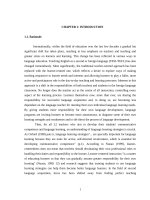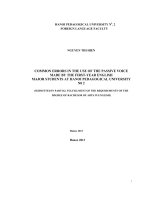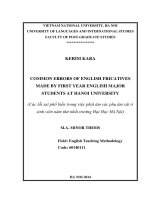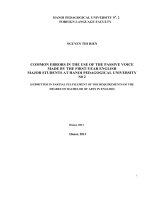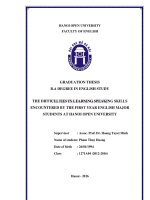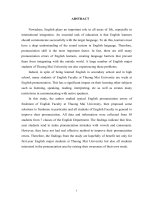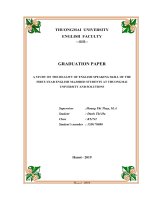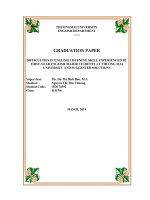Some typical pronunciation errors made by first year english major students at thuong mai university
Bạn đang xem bản rút gọn của tài liệu. Xem và tải ngay bản đầy đủ của tài liệu tại đây (447.5 KB, 52 trang )
ABSTRACT
Nowadays, English plays an important role in all areas of life, especially in
international integration. An essential task of education is that English learners
should communicate successfully with the target language. To do this, learners must
have a deep understanding of the sound system in English language. Therefore,
pronunciation skill is the most important factor. In fact, there are still many
pronunciation errors of English learners, creating language barriers that prevent
them from integrating with the outside world. A large number of English major
students of Thuong Mai University are also experiencing these problems.
Indeed, in spite of being learned English in secondary school and in high
school, many students of English Faculty at Thuong Mai University are weak at
English pronunciation. This has a significant impact on their learning other subjects
such as listening, speaking, reading, interpreting, etc as well as creates many
restrictions in communicating with native speakers.
In this study, the author studied typical English pronunciation errors of
freshmen of English Faculty at Thuong Mai University, then proposed some
solutions to freshmen in particular and all students of English Faculty in general to
improve their pronunciation. All data and information were collected from 50
students from 7 classes of the English Department. The findings indicate that firstyear students tend to make pronunciation mistakes with vowels and consonants.
However, they have not had real effective method to improve their pronunciation
errors. Therefore, the findings from the study are hopefully of benefit not only for
first-year English major students at Thuong Mai University but also all students
interested in the pronunciation area by raising their awareness of their own study.
1
1
ACKNOWLEDGEMENT
When completing this graduation paper, I would like to express my deepest
and most sincere thanks to many people for their invaluable help in the process of
conducting research.
First and foremost, I would like to send my sincere gratitude towards my
supervisor Ms. Do Thi Bich Dao, for her constructive and timely feedbacks as well
as her continuous encouragement from the beginning and through the study process.
Without her help, I could not finish my graduation paper.
I would love to thank all the teachers at Thuong Mai University for bringing
me the world of knowledge during my course and helping me complete this
important document. I would also like to send my sincerest gratitude to all first-year
students who have enthusiastically participated in the study. Their participation has
been important to this research.
Last but not least, I want to send my truly thanks to my family and friends for
their endless love and support through the challenging time of conducting the
research. Without the encouragement of them, I could not have got this far.
2
2
TABLE OF CONTENTS
LIST OF TABLES, FIGURES AND CHARTS
List of tables
Table 1.1. Participants from seven classes
Table 3.1 Student’s English background information
Table 3.2 Student’s used method and program in learning English pronunciation
skill
Table 3.3 The efficiency of students’ method /program in improving English
pronunciation
List of figures
Figure 2.1 Places of articulation (Roach, 1983: 8)
Figure 2.2 Primary cardinal vowels
Figure 2.3 Chart of English Consonant Phonemes
List of charts
3
3
4
4
LIST OF ABBREVIATIONS
•
•
•
•
•
•
•
EU: European Union
EFL: English as a Foreign Language
ESL: English as a Second Language
TMU: Thuong Mai University
VPM: Voices, Place and Manner
RP: Received Pronunciation
N, V, A: Noun, Verb, Adjective
5
5
CHAPTER 1: OVERVIEW OF THE STUDY
1.1.
Rationale
Nowadays, English has become the global language. Among hundreds of
different languages, the world has chosen English as a mean for people to
understand each other. English is the official language of 53 countries and
territories, the official language of the EU and the third widely used language after
Chinese and Spanish. The international events like the Olympics, global
organizations, and multinational companies consider English as common language
of communication. Vietnam is also one of the countries which use English as the
second language. Therefore, English plays an important role in Education sector as
one of the main subjects in many schools in Vietnam. This shows the importance of
English in all fields of economy, culture, society, etc.
However, a sad fact that Vietnamese young people are learning English as a
formal subject at school but almost still express to be lack self when communicating
with foreigners. Many students after graduation still cannot speak more than simple
sentence such as greetings and introduce themselves. The reason is that they cannot
pronounce English words correctly which discourages them from talking and
communication. To master a language is not easy at all. We often hear about four
skills of listening, speaking, reading and writing in English but forgetting that
pronunciation is also one of the important skills. If learners want to listen to English
well, they must first say it correctly and pronounce it correctly. That requires a
knowledge system of vocabulary and the process of practicing pronunciation, word
and sentence stress. If learners pronounce one word wrongly, when they hear the
native speakers say that word, they cannot understand it because they may find the
word very strange, not recognizing it and as a result English learners do not
understand the whole sentence. Besides, if learners speak wrongly, native speakers
cannot understand what they are saying or cause misunderstandings.
At Thuong Mai University, most of first-year English major students still have
many mistakes in pronunciation. If English learners want to communicate fluently,
English learners have to repair pronunciation mistake as soon as possible, especially
at the first year at university. There are many pronunciation errors that learners
6
6
make such as words and sentence stress, intonation, linking sound, length of vowel
sounds, ending sounds etc. This is one of the most disturbing things for students
pursuing an English-related career in the future if there is no method to change and
overcome. From the reasons mentioned above, to improve student’s pronunciation,
the researcher has decided to carry out the study entitled "Some typical
pronunciation errors made by first-year English major students at Thuong Mai
1.2.
University".
Previous studies
Prior to the 1980s, the pronunciation field was less interested not only in
language teaching at schools, but also in the found literature. There were not much
researches about pronunciation errors. According to Brown (1991), among 1420
articles in four leading English teaching journals, only 95 of them investigated
pronunciation. In other words, between 1975 and 1988, the rate of the articles
related to pronunciation is only 7.6 %.
After 1980 and onward, people began to pay attention to communication
methods and the pronunciation prerequisite skill has been made as the “Intelligible
pronunciation is an essential component of communicative competence” (Morley,
1991). Because of that, many researchers started to find out about different issues
such as the influence of the factors on second language acquisition of pronunciation
(Moyer, 1999; Thompson, 1991; Flege, Munro, & MacKay, 1995). When the
researchers learned about the segmental aspects which are consonants and vowels,
they have realized the importance of the suprasegmental features such as stress,
rhythm, intonation to maintain the healthy conversations (Celce-Murcia et al. 1996).
Finally, the study has been conducted with a pragmatic aim. These researches
were made to investigate the pronunciation errors of the EFL learners so as to
describe the current situations of the students in terms of pronunciation
development, to define what extent the curriculum serves the aim of pronunciation
teaching with the chosen documents like coursebooks. Thank for these studies, it is
easier for teachers in preventing these errors from becoming fossilized errors and
designing the lessons according to the needs of the learners (Hojati, 2013; Kaçmaz,
1993; Hişmanoğlu, 2011; Tergujeff, 2012; Gordani & Khajavi, 2012).
The research about “Teaching English Intonation to ESL/EFL Students”,
Mehmet Celik, (2001), Hacettepe University, Turkey put forward a framework of
7
7
English intonation as a second of foreign language to non- native speakers of
English. That English intonation framework should include four main
characteristics of intonation: intonation units, stress, tone and pitch range.
Therefore, the phenomena of intonation in English should have a part of utterance,
intonation unit, as a basis for studying all kinds of movements and features of the
voice. Each intonation unit has a type of tonic stress: (unmarked) utterance-final
tonic stress, or emphatic, or contrastive, or new information stress, the last of which
is more frequently used in utterances given to wh-questions. Moreover, intonation
units often have one of these tones: low-rise, high-rise, fall and fall-rise. Tones are
assigned to intonation units related to the type of voice movement on syllables.
Finally, all intonation units must be said in one of three levels: high, mid and low.
Although this framework may be ratified to be useful and feasible for
pronunciation practitioners in the field of ESL/EFL (English as a Second Language/
English as a Foreign Language), it seems to be rather general and theoretical. In
order to pronounce perfectly, English learners need to focus on many different
aspects such as intonation, stress, vowel, consonant, ending sounds, link word, etc.
Besides, an equally important thing is how to present the pronunciation way of
vowels and consonants because they seem to be the basic things in pronunciation
1.3.
learning processing.
Aims of the study
Initially, the researcher wants to find out the most common pronunciation
errors made by first- year English major students of TMU.
Secondly, the researcher desires to draw out an appreciate approach to help
improve the English pronunciation skill of English learners in general and first-year
English major students of TMU in particular. More specifically, the study is an
attempt to answer the two research questions:
- What are typical pronunciation errors that first-year English major students
of TMU often make?
- What are methods for first- year English major students to overcome English
1.4.
pronunciation errors?
Research Subjects
Firstly, the aim of the researcher is to find out the typical pronunciation errors
of first-year English major students at TMU, thus only first-year students of English
faculty at TMU would be the main research subjects of the study. Most of the
8
8
freshmen are in rural areas from different provinces. Therefore, their pronunciation
is greatly influenced by the local language, especially students in Nghe An, Ha
Tinh, Quang Binh, Quang Ngai, etc. In addition, the process of learning English at
high schools of these students mainly focuses on grammar for exam preparation, not
investing time to practice pronunciation skills and speaking skills. Besides, the
teaching method at the university is different from the teaching method at high
school. If in high school, the students are dedicated by the teachers to instruct step
by step, in the university environment, students must be more self-aware in learning
1.5.
with the guidance of teachers.
Scope of the study
Because of the small scale of the study as well as the limitation of time,
expense and experience, the study concretely places a focus on the freshmen of
English major at TMU. Specifically, there are 50 first-year students from classes at
English faculty of TMU participating in this study with a survey research design.
Besides, the researcher will also choose 5 out of those 50 students to take part in a
direct interview. These students are from both rural and urban areas.
As the researcher mentioned in the " Research subject" part, the aim of the
study is to find out the typical pronunciation errors of first-year English major
students at TMU, therefore the researcher only finds out about pronunciation
1.6.
aspects, not focusing on other skills such as speaking, reading, writing and listening.
Research methodology
1.6.1. Setting
The quantitative data collection process was carried out through a survey
questionnaire with the participation of 50 students who were randomly selected
from seven classes of English Faculty at TMU. After that, the researcher created a
direct interview to ask 5 out of the 50 selected students about difficulties in English
pronunciation, the mistakes they often make and the methods they used to improve
English pronunciation skills.
1.6.2. Sampling
The participants in the research was first-year English major students at TMU.
There were in total 50 students from seven classes, accounted for roughly one- fifth,
or 20% of the students participated in the questionnaire. Most of them are female,
which really reflects the male-female ratio in TMU because more than 80 percent of
9
9
students in English Faculty are female. All of participants had the same
backgrounds in terms of English language education in their state school before.
They currently have two subjects relating to English pronouncing including the
"Speaking Skills" (3 credits) and the "Basic communication English" (2 credits),
creating approximately 270 minutes for a week to practice English pronunciation at
school. The researcher used the convenient sampling procedure. The findings from
the sample could not be generalized to all students; however, the larger number of
the participants can compensate for this limitation to some extent.
The specific number of the participants from each class is as follows:
Class
K54N1
K54N2
K54N3
K54N4
K54N5
K54N6
K54N7
Number of participants
5
3
9
6
12
8
7
Table 1.1. Participants from seven classes
1.6.3. Data collection
1.6.3.1. Data collection instruments
In the study, the researcher used two different types of data collection tools to
find out the answers to two research questions. The first is the survey questionnaire;
the second is personal interview.
10
10
1.6.3.2. Survey questionnaire
1.6.3.2.1. Aims of the questionnaire
According to Paul J. Lavrekas, questionnaire “is a set of standardized
questions, often called items, which follow a fixed scheme in order to collect
individual data about one or more specific topics” (2008). This research tool is the
most popular, effective and time-saving for data and information collection.
Because the items in the questionnaire often ask about specific information, hence,
using the survey questionnaire in the study helps to "gather relatively
straightforward factual data in response to closed questions" (Gillham, 2005, p.166).
In addition, specific information collected from a large number of respondents in a
relatively short period of time makes the questionnaire very suitable for quantitative
and statistical analysis.
1.6.3.2.2. Questionnaire design
All information received from the questionnaires will be kept confidential in
any way. The questionnaire requires participants to provide their class for the
purpose of controlling the number of participants in each class answering the
questionnaire.
In addition to asking participants to provide information about names, ages
and grades, the researcher designed the questionnaire with three sections of 9
questions. Part A of the questionnaire contains 4 questions relating background
information about English pronunciation skill of participants. Part B with 3 major
questions, is focused on the difficulties in pronouncing English of participants. The
first question contains 7 small items in relation to factors affecting English
pronunciation. The second question consists of 5 small items to survey about
aspects of pronunciation that students face difficulties.The third question has 15
items in relation to specific sounds that students often make mistakes. Part C
includes two questions, in which question number 8 is divided into 6 small items.
All questions relate to the strategies and methods which participants used to
overcome difficulties, common errors in English pronunciation.
The content of the survey questionnaire is suitable for research because the
researcher wants to come up with an appreciate method to help improve
11
11
pronunciation skills. To prepare for the survey questionnaire, the researcher
designed a systematic series of detailed alternative questions carefully before
conducting the survey (See Appendix 1).
1.6.3.3. Personal interview
1.6.3.3.1. Aims of the personal interview
The purpose of conducting a personal interview is to explore the responses of
the people to gather more and deeper information and at the same time, to observe
the behavior of the respondents, either individually or as a group.
1.6.3.3.2. Personal interview design
The researcher has a list of questions or key points that need to be mentioned
and interviewed in a methodical way. Respondents will be asked similar questions,
although additional questions may be asked in some certain cases. In order for the
interview to be highly effective, the researcher will record the answers of
respondents with their permission and take them home to summarize the obtained
information for analysis.
1.6.4. Procedures for data collection and analysis
The researcher collected data through questionnaires and individual interview
surveys. All questions used are reasonable and consistent with the aims of the study.
After collecting survey questionnaires from 50 students of the classes while
the recordings obtained during the interview process are being processed, all the
figures and observation diagrams with information gathered from the participants
were used for analysis. All ideas and methods collected from students were counted
in the table in the results section. The quantitative data collected in survey
questionnaires were converted into percentages and displayed as charts and tables.
Recording files saved in the smartphone were collected and the researcher checked
them to note some information. The results, then, are compared with comments and
notes taken from research observations
Finally, data is processed by both statistical and interpretive methods. They
have been clarified and summarized into tables and charts for later generalization.
Comments and evaluations were given by the researcher relating to relevant
knowledge in previous studies are presented in chapter 1. From statistics and
12
12
findings, some solutions for the pronunciation errors of first- year students in K54
was found.
1.7.
Organization of the study
The research is divided into four main chapters: Overview of the study,
Literature review, Research findings, Recommendations and suggestions. More
specifically, the contents consist of four chapters are as follows:
Chapter one (Overview of the study) includes the rationale, previous studies
and the aims of the study. In addition, it provides the research subjects, the scope,
methodology and the organization of the study.
Chapter two (Literature review) which presents theories related to the study.
The researcher discusses the literature on typical English pronunciation errors
including the key terms together with the review of related studies.
In chapter three (Research findings), the researcher describe research process,
presents and analyze the research results.
In chapter four (Recommendations and suggestion) the researcher summarizes
the major findings, suggests some pedagogical implications from those findings,
acknowledges the limitation of the research and finds out solutions for the problem.
13
13
CHAPTER 2: LITERATURE REVIEW
2.1. English pronunciation
2.1.1. Definition of pronunciation
Most people think of pronunciation as the sounds we make while speaking.
According to the research about "ESL Students' Opinions about Instruction in
Pronunciation" of Madden, et al (1997), "Pronunciation is often simplified to mean
the production of phonetic/phonemic sounds of a language" (p.2)
According to the research about "What is pronunciation?" of AMEP research
centre (2002) "Pronunciation refers to the production of sounds that we use to make
meaning.” (p.1). It consist of some aspects such as specific sounds of language
(segments), intonation, phrasing, stress, timing, rhythm (suprasegmental aspects)
and voice quality. Abbas Pourhossein Gilakjani said that "Pronunciation is viewed
as a sub-skill of speaking." (2011, p. 74)
According to Fraenkel (1984), there are two main steps to learning how to
pronounce a language. The first step is the reception phase. By this stage, language
learners learn to distinguish important sounds and patterns by listening to the
language. The second stage is speaking, in which learners learn to say or create
what we have learned before.
2.1.2. Aspects of pronunciation
2.1.2.1. Articulatory phonetics
2.1.2.1.1. Articulators
We know that humans make speech by bringing air from the lungs through the
larynx, where vocal folds may or may not vibrate. And the airflow is then shaped by
the articulators.
In the book "English Phonetics and Phonology" (Roach, 1995), it is mentioned
that muscles contracting is the main reason creating all the sound when we speak.
The chest muscles that we use to breathe create the air flow that is necessary for
almost all speech sounds. The muscles in the larynx create many different
modifications in the air flow from the chest to the mouth. After passing through the
larynx, the air passes through what we call the vocal tract, ending in the mouth and
nostrils. Here the air from the lungs escapes into the atmosphere. We have a large
and complex muscle set that can make changes in the shape of the vocal tract, and
14
14
to learn how to make the sound of speech, it is essential to be familiar with the
different parts of the vocal tract. These different parts are called articulators, and
their study is called phonetic articulation.
The articulators include the following parts: larynx, pharynx, soft palate
(velum), hard palate, tongue, alveolar ridge, nose, upper teeth, lower teeth, upper
lip, lower lip.
Look at the diagram below to see where each part of the articulators is:
Figure 2.1 Places of articulation (Roach, 1983: 8)
2.1.2.1.2. The process of producing sounds
Beside mentioning about the articulators above the larynx, the book "English
Phonetics and Phonology" (Roach, 1995) also describes how the sounds are
produced in the following way: When a person is making sound, the air from the
lungs passes through the trachea and comes first at the larynx. Then it passes
through the vocal cords into the throat, and up throat to the tongue. At this point,
there are two cases. If the soft palate is lifted, it can enter the oral cavity and go out
of the mouth. Or it may enter the nasal tract if the soft palate is lowered and escape
through the nostril.
2.1.2.2. English sounds
There are 44 sounds in English including 20 vowel sounds (with 12 vowels, 8
diphthongs) and 24 consonants sounds.
2.1.2.2.1. Vowel Sounds
According to Roach (2000), vowels are "sounds in the production of which
there is no obstruction to the flow of air as it passes the larynx to the lips" (p.10).
They "are the type of sounds that depend mainly on the variations in the position of
the tongue. They are normally voiced." Vowels are divided into two groups:
15
15
monophthongs and diphthongs. In the research, the author only focuses on the
monophthongs.
Generally monophthongs can be classified according to four variables:
• Tongue height
+ High vowels: In making sound process, the tongue is high in the mouth. It is
raised above its rest position. E.g: /i:/, /u:/, /ɪ/, /ʊ/
+ Low vowels: are vowels created with the tongue below its rest position. E.g:
/a:/, /æ/
+ Mid vowels: are vowels created with the tongue neither high nor low in the
mouth.
E.g: /e/, /ɒ/, /ə/, /ɔː/, /ɜː/
• The part of the tongue
+ Front vowels: In making sound process, the front of the tongue is the highest
point.
E.g: /i:/, /e/, /ɜː/, /æ/, /ɪ/
+ Back vowels: In making sound process, the back of the tongue is the highest
point.
E.g: /u:/, /ʊ/, /ɒ/, /ɔː/, /a:/
+ Central vowels: are vowels created with neither the front nor the back of the
tongue. The tongue is neither high nor low in the mouth. E.g: /ə/, /ʌ/
• Degree of lip rounding
+ Rounded vowels: are vowels created with rounded lips. The corners of the
lips are brought towards each other and the lips are pushed forwards. E.g: /ʊ/,
/u:/, /ɒ/, /ɔː/
+ Unrounded vowels: are vowels created with the lips spread. The corners of the
lips are moved away from each other as for smile. E.g: /i:/, /e/, /ɜː/, /æ/, /ɪ/, /ʌ/, /a:/
+ Neutral vowels: are vowels with the lips neither rounded nor spread. E.g: /ə/
• The length of sounds:
+ Short vowels: /ɪ/, /e/, /æ/, /ʌ/, /ʊ/, /ɒ/
+ Long vowels: /i:/, /u:/, /ɔ:/, /ɜː/,/a:/
16
16
Figure 2.2 Primary cardinal vowels
2.1.2.2.2. Consonant Sounds
Roach (1995) defined consonants “are the sounds in the production of which
one articulator moves towards another or two articulators come together,
obstructing the air- stream cannot get out freely".
In English, there are 24 consonants including: /p/, /b/, /t/, /d/, /t∫/, /dʒ/, /k/,
/g/, /f/, /v/, /ð/, /θ/, /s/, /z/, /∫/, /η/, /r/, /w/, /m/, /n/, /l/, /h/, /ʒ/, /j /
Consonants are often categorized by being called VPM - labels. VPM stands
for Voices, Place and Manner:
•
The place of articulation is where the airflow will be more or less obstructed.
According to the place of articulation, consonants can be classified:
+ Bilabial: are sounds created with lips pressed together or coming together,
including: /p/, /b/, /m/, /w/
+ Labio- dentals: are the sounds created with the lower lip touching the upper
front teeth, including: /f/, /v/
+ Dentals: the sounds are made with the tip of the tongue touching the upper
front teeth or between the lower and the upper teeth, including: /ð/, /θ/
+ Alveolars: the sounds are generated with the tip of a tongue or approaching
the alveolar ridge, including: /t/, /d/, /s/, /z/, /l/, /n/
+ Retroflex: the sound is created with the tip of the tongue curling back behind
the alveolar ridge, including: /r/
17
17
+ Palato- alveolar: the sounds are made with the tip of the tongue coming near
the area between the back of the alveolar ridge and the front of the hard palate,
including: /t∫/, /dʒ/, /ʒ/, /∫/
+ Palatal: the sound is created with the front of the tongue coming near the
hard palate, including: /j/
+ Velars: the sounds are made with the back of the tongue touching the soft
palate, including: /k/, /g/, /η/
+ Glottals: the sound is created without using of the tongue and other parts of
the mouth, including: /h/
•
Manner of articulation is the way in which the flow of air is obstructed or altered in
the production of speech. According to the manner of articulation, consonants can
be classified:
+ Plosives: the sounds are created when the flow of air is completely stopped
in the oral cavity and the soft palate is lifted blocking off the nasal cavity. After that,
the two articulators separate quickly and the air escaped through the mouth.
E.g: /p/, /t/, /k/, /b/, /d/, /g/
+ Fricatives: the sounds are made when the flow of air is partially stopped,
then gradually released, i.e an audible friction noise is produced.
E.g: /f/, /v/, /θ/, /ʒ/, /∫/, /s/, /z/, /ð/, /h/
+ Affricates: the sounds are produced when stops are immediately followed by
a fricative. E.g: /dʒ/, /tʃ/
+ Nasals: the sounds are produced when the airflow is stopped in the oral
cavity but the soft palate is down so that the air can go out through the nose. E.g:
/m/, /n/, /η/
+ Lateral: the sound is made when the airstream goes through both sides of the
mouth.
E.g: /l/
+ Approximants: the sounds are produced when the air flow quickly glides to
the sound. E.g: /w/, /r/, /j/
•
Voicing means that the vocal folds are used, if they are not, the sound is voiceless.
According to voicing, consonants can be classified:
18
18
+ No vibration means voiceless (9 sounds) – Fortis: /p/, /t/, /k/, /f/, /θ/, /s/,
/h/, /∫/, /tʃ/
+ Vibration means voiced (15 sounds) - Lenis: /b/, /d/, /g/, /v/, /ð/, /z/, /ʒ/,
/dʒ/, /m/, /n/, /η/, /1/, /r/, /w/, /j/.
Figure 2.3 Chart of English Consonant Phonemes
Stress
2.1.2.3.
Stress is an extra force exerted on a particular syllable or a particular word in
spoken language. This stress syllable or word is said with greater energy. “It is
pronounced with more strength, it lasts longer, and it reaches a higher pitch than the
surrounding syllables, it also differs from them.” (Roach, 1995)
•
There are two types of stress
+ The stress placed on syllables within words is called word stress or lexical
stress.
+ The stress placed on words within sentences is called sentence stress or
prosodic stress.
In the research, the author just focuses on the first type of stress- lexical stress.
•
Placement of stress within words
In the book "Phonetics and Phonology" (Roach, 1995), it is mentioned about
the placement of stress within words. To decide on the stress placement, it is needed
to make use of some or all of the following information:
19
19
+ The grammatical category to which the word belongs to (N, V, A, etc)
+ The number of syllables in the word
+ The phonological structure of the word
+ The word is morphologically simple or complex.
•
Some lexical stress principles cited in “English Phonetics and Phonology” (Roach,
1995)
Note: These principles are only relative, because there are still exceptions.
- Two- syllable words
+ In the most two syllable nouns and adjectives, the first syllable takes on the
stress.
E.g: HAPpy, BORing, LAPtop, TAble, etc.
+ In the most two syllable verbs and prepositions, the stress is on the second
syllable.
E.g: beGIN, deCIDE, betWEEN, beSIDE, etc.
+ About 80% of two syllable words get their stress on the first syllable
- Three - syllable word
+ For three- syllable words ending with the suffixes er or ly, the stress is
placed on the first syllable.
E.g: ORderly, MAnager, etc.
+ The stress is going to be on the syllable right before the suffix such as: able,
ial, cian, ery, ian, ible, ic, ics, ion, ia, ient, ious, ish, (o)sis.
E.g: DURable, SOcial, muSIcian, BAKery, coMEdian, imPOsible, iONic,
TOpics, repoSItion, MEdia, ANcient, VARious, ENGlish, osMOsis.
Note: This way just applies to words of all syllable lengths.
+ Words that use the suffix -ade, -ee, -ese, -eer, -que, -ette or -oon have the
primary stress actually placed on the suffix.
E.g: lemoNADE, aGREE, carTOON, unIQUE, etc
+ Words ending in -cy, -ty, -phy, -gy, and -ies, -ate, stress on the third from end
syllable. E.g: geOLogy, ORganise, CONcentrate, etc
- Compound words
20
20
+ In a compound noun, the most stress is on the stressed syllable of the first
word.
E.g: GREENhouse, FOOTball, etc.
+ In compound adjectives, the most stress is placed in the stressed syllable of
the second word.
E.g: old- FASHioned, bad-TEMpered, etc
+ In compound verbs, the stress is on the second or on the last part.
E.g: underSTAND, deTESTS, etc.
+ In noun + compound noun, the stress is on the first word.
E.g: PROject manager, BOARD member, etc.
2.1.2.4.
Intonation
“Intonation is the melody of the sentence. Intonation is created by changes in
the pitch of the voice, by sentence stress, and by rhythm.” (Roach, 1995).
The most important hypotheses of intonation are to differentiate sentence
types and divide sentences into meaningful groups. Besides, intonation also helps
speakers express many different emotions. Unlike lexical stress, changing
intonation does not change the vocabulary identity or meaning of individual words,
although it can alter the whole meaning of the sentence.
According to Cambridge dictionary, there are three main types of intonation in
English including: falling intonation, rising intonation and fall-rise intonation.
• Falling intonation
Falling intonation describes how the voice falls on the last stressed syllable of
a phrase or a group of words. It is used at the end of statements, special questions,
commands sentences, in the first part of tag questions and in the last part of
alternative questions.
• Rising intonation
Rising intonation describes how the voice rises at the end of a sentence. Rising
intonation is common in yes-no questions. It is also used at the end of general
questions, in requests, at the end of introductory phrase beginning sentence, in the
second part of tag questions, in direct address, in the first part of alternative
questions, etc.
21
21
• Fall-rise intonation
Fall-rise intonation describes how the voice falls and then rises. It expresses
non- finality, signals continuation of the utterance, emphasizes the word on which it
is used and may express polite warning, suggestion, correction, contrast and so on.
2.1.2.5.
Linking sounds
The followings are the most familiar cases of the use of linking:
• Consonant to vowel linking
The final consonant of word is associated with the first vowel sound of the
following word.
E.g: “These are old eggs” [ði:.zə.rəʊl.degz]
• Vowel to vowel linking
When certain vowels come side by side, an extra sound is added to make the
link smooth.
E.g: “See it” [si:jɪt]
• Linking and intrusive "r"
In standard British English (RP), the letter 'r' after a vowel sound at the end of
the word is usually not pronounced. However, when the following word starts with
vowels, the /r/ sound is pronounced to create a smooth link.
E.g: “might rain” [mait rein] (r voiced when initial in “rain”, ai short)
“my train” [mai trein] (r voiceless following t in “train”)
2.2. English pronunciation errors
2.2.1. What are English pronunciation errors?
When learning any language, it is difficult for us to avoid making errors. In
pronunciation, errors are defined as “variants of pronunciation which prevent one
communicator from understanding the propositional content of the other’s
utterances” (Jenkins, 2006).
In 1960s, it was considered that pronunciation errors was a failure in learning
that could not be forgiven (Lewood, 1984). Although today people have a more
lenient view of errors in language learning, but non-native people should try to
improve pronunciation errors in order to achieve the best results in communication.
22
22
Richards (1971) argues that there are two different types of pronunciation
errors including: performance errors, caused by, for example, fatigue and lack of
concentration, and capacity errors due to lack of knowledge of language rules.
2.2.2. Factors affecting English pronunciation of students
2.2.2.1 Attitude
According to Elliot (1995), attitude of language learners towards native or
near- native pronunciation is an important factor influencing the pronunciation of
the target language. In other words, if language learners pay more attention to their
pronunciation of the target language, they will pronounce better. Earlier, Suter
(1976) also realized that language learners who are more interested in their
pronunciation (p. 249) have a better pronunciation of English as a second language
(Elliot, 1995).
2.2.2.2. Motivation
Motivation is really a variable that can create a difference. The higher learner's
motivation, the better their ability to pronounce. When learners have a certain goal
to learn English, they will have the need and desire for native-like pronunciation
(Marinova-Todd et al., 2000; Masgoret & Gardner, 2003; Bernaus, Masgoret,
Gardner, & Reyes, 2004; Gatbonton et al., 2005). Sparks and Glachow (1991) also
stated that ''students with motivation to learn with positive attitudes towards the
target language and its speakers were more successful than were students with less
positive attitudes.'' (Abbas Pourhosein Gilakjani, 2012)
2.2.2.3. Instruction
One of the main reasons for students’ pronunciation errors is that they are not
taught this skill carefully and clearly at school. In the process of teaching foreign
language, there are four skills that are highly valued by teachers including listening,
speaking, reading and writing. Teachers argue that pronunciation is less important
than the other four skills, so they often ignore pronunciation teaching to focus on
those skills. The language curriculum at the school often emphasizes pronunciation
only in the first year to introduce the alphabet and vowel and consonant system of
the target language, but seldom keep this focus beyond the introductory level.
2.2.2.4. Exposure to English
23
23
It is not surprised that English learners who live in English speaking
environment get better pronunciation faster than those who have little opportunities
to interact with English. The more they are exposed to English, the faster they can
improve their English pronunciation.
Learning and speaking a new language is a major barrier for foreign language
learners because good oral communication requires the speaker to be able to use
rich language in many cases. In addition, to speak well a language, some factors
such as stress, intonation, pitch or non-linguistic factors related to language such as
gestures, facial expressions, and body language are also extremely important.
Students cannot learn these things from books and have to go through real
experiences.
According to Shumin (1997), because of the lack of contact with the target
language and the native speakers, adult English learners often do not achieve a
native- like level of pronunciation with the fluency, and good control of idioms,
gestures, body language and facial expressions.
2.2.2.5. Mother tongue
An equally important factor influencing the English pronunciation that the
researcher wants to mention is the transformation or intervention from the mother
tongue. The ability to pronounce English may be affected by "a transfer from the
native language; an analogy with something correctly learned in the foreign
language; a wild guess, vagueness in remembering the right form; or general lack of
accuracy and language skill.” (MacKay, 1967). Because of the difference in the
sound system between the target language and the source language as well as the
challenges of the fossilised sound system of learners’ mother tongue, it is more
difficult to acquire the second language's sound system.
2.2.3. English pronunciation errors made by Vietnamese learners
2.2.3.1. Vowel pronunciation errors
•
/i:/ versus /ɪ/
Many Vietnamese learn English often make the mistakes with two sounds /i:/
and /ɪ/. Learners cannot find the differences between these sounds or the findings
are very vague. /ɪ/ is a short vowel but /i:/ is a long one. However, when
24
24
pronouncing them, Vietnamese pronounce both sounds exactly the same. The
reasons of this error is the wrong manner English learners pronounce these sounds
and also, relate to the incorrect position English learners put their articulators to
make the sounds.
•
/u:/ versus /ʊ/
When learning how to pronounce /u:/ and /ʊ/ sounds, Vietnamese can
recognize the differences between them. However, there are many English words
containing ‘oo’ that may be pronounced as neither /u:/ nor /ʊ/. For example, in the
word ‘wood’, 'oo' is pronounced /ʊ/, but in the word 'noon', 'oo' is pronounced /u:/.
This can create confusion for English learners. Therefore, learners often make the
mistakes with both /u:/ and /ʊ/ sounds.
•
/e/ versus /æ/
"Vietnamese students cannot identify the vowel /e/ and /æ/, such as in bed and
bad (Avery & Ehrlich, p. 156)" (Nguyen Tien Dung, 2014). This confusion is one of
the most serious problems that Vietnamese have to face when they learn English
vowels. They cannot determine the differences, thus learners often make many
mistakes with these sounds. According to Avery & Ehrlich, “students often pronounce
these two vowels in exactly the same way. Most commonly, students fail to lower their
tongue and jaw far enough in attempting to produce the /æ/ sound” (p. 99).
2.2.3.2. Consonant pronunciation errors
According to Honey, “the Vietnamese consonant system is very different from
that of the English, and there is considerable variation between dialects". (p.240).
According to Avery & Ehrlich’s statement, “Vietnamese has no voiced stops at the
ends of words” (1992, p. 154). Perhaps because of these differences, many
Vietnamese feel very difficult in pronouncing some English consonants. Some
errors about English consonants summarized as below are problems that most
Vietnamese speakers, even those who are very fluent in English still encounter.
•
/s/ versus /z/
When learning English, Vietnamese often get confused between /s/ and /z/ and
they replace /s/ for /z/. There are two types of problem related to the /s/ sound. The
first problem is that in the spelling of some words, the /s/ sound is omitted. The
25
25
